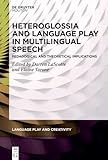Heteroglossia and Language Play in Multilingual Speech : Pedagogical and Theoretical Implications / ed. by Darren LaScotte, Elaine Tarone.
Material type: TextSeries: Language Play and Creativity [LPC] ; 9Publisher: Berlin ; Boston : De Gruyter Mouton, [2024]Copyright date: 2024Description: 1 online resource (VI, 208 p.)Content type:
TextSeries: Language Play and Creativity [LPC] ; 9Publisher: Berlin ; Boston : De Gruyter Mouton, [2024]Copyright date: 2024Description: 1 online resource (VI, 208 p.)Content type: - 9783110787566
- 9783110787849
- 9783110787696
- online - DeGruyter
- Issued also in print.
| Item type | Current library | Call number | URL | Status | Notes | Barcode | |
|---|---|---|---|---|---|---|---|
 eBook
eBook
|
Biblioteca "Angelicum" Pont. Univ. S.Tommaso d'Aquino Nuvola online | online - DeGruyter (Browse shelf(Opens below)) | Online access | Not for loan (Accesso limitato) | Accesso per gli utenti autorizzati / Access for authorized users | (dgr)9783110787696 |
Frontmatter -- Contents -- Chapter 1 Introduction to heteroglossia and language play in multilingual speech -- Chapter 2 Getting serious about language play: Language play, interlanguage variation and second language acquisition -- Chapter 3 Voice, stance, and role in Chinese immersion second graders’ language use -- Chapter 4 Escríbalo en tu own words, güey -- Chapter 5 Pedagogical language play in a beginning L2 Chinese classroom -- Chapter 6 Translanguaging and language play -- Chapter 7 Language play and social positioning in L2 narrative retells -- Chapter 8 Channeling Charlie: Suprasegmental pronunciation in a second language learner’s performance of others’ voices -- Chapter 9 Coda: Pedagogical implications and applications for language play beyond second/foreign language learning -- Subject Index
restricted access online access with authorization star
http://purl.org/coar/access_right/c_16ec
The studies in this volume show how multilingual learners use language play in second language acquisition to internalize sets of ‘voices’ (rather than decontextualized linguistic systems), namely complexes of linguistic and non-linguistic features incorporating the personalities of significant others. In sociocultural terms, these internalized heteroglossic voices become tools that learners can adapt and use playfully to enact chosen roles, stances, and identities in subsequent oral interactions. Different chapters explore these sociocultural constructs using different approaches, including variationist sociolinguistics, conversation analysis, translanguaging, and positioning theory.
Issued also in print.
Mode of access: Internet via World Wide Web.
In English.
Description based on online resource; title from PDF title page (publisher's Web site, viewed 20. Nov 2024)


